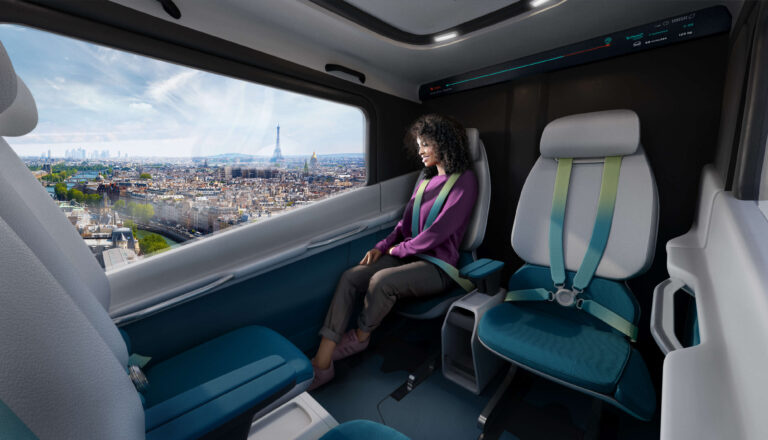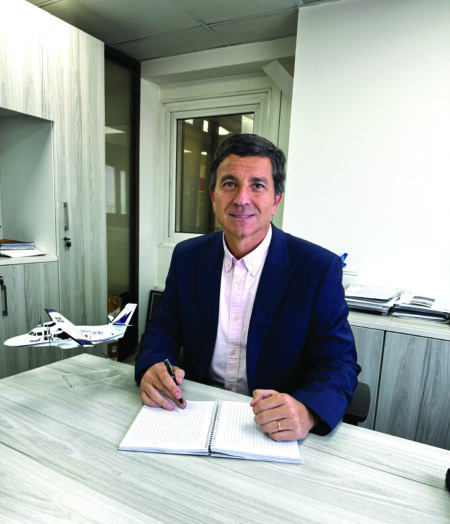Recent research has highlighted the strong appeal of electric vertical take-off and landing vehicles (eVTOLs) in the UAE. Commissioned by the organizer of Aircraft Interiors Expo (AIX), and conducted by Censuswide, the research surveyed 250 high-net-worth individuals (HNWIs) in the UAE – senior business executives with a household income exceeding £250,000 (€296,915/US$324,908). It found that 96.4% are likely to consider using an eVTOL for future business travel.
The research, which drilled down into expectations for eVTOL interiors, is revealed here.
Business jet frustrations
All the survey respondents travelled by private business jet at least once a year – the average (mean) was 8.03 times a year. However, 83.6% felt some features or aspects of business jet interiors were outdated and shouldn’t be carried over to eVTOLs. One aspect they did value in business jets was the opportunity for customization of aspects such as colors, lighting and entertainment. Nearly all (97.6%) would value a similar level of customization in eVTOLs. However, Ben Orson, founder of Orson Associates points out that each type of eVTOL operation has “different economies of scale around how many of each item are required, which will apply constraints on what you can and cannot do”.
For an individual purchaser, customization could be comparable to in a business jet, but most eVTOL flights will be shorter, with no need for bathrooms, refreshments, or the ability to walk around. “For small eVTOLs, we need to look to automotive more than anything else for inspiration,” Orson says. “They have problems around making people comfortable for a relatively short time within a confined environment and do it extremely well.”
Cabin wish list
Survey respondents were asked which factors would most enhance their experience on a short-haul (20 to 50 minute) eVTOL flight. 26.4% said advanced in flight entertainment (IFE) and seamless connectivity (24%) were the top choices, followed by seating comfort (20.4%); cabin aesthetics (17.6%) and lighting (11.6%).
Heads Up Technologies is engaged with eVTOL OEMs on the cabin management system (CMS), IFE, lighting, audio and safety items. “We’re working with the OEMs to give them the building blocks and design products that help reduce weight and power consumption to increase range,” says Brendan Lanigan, director of product management at Heads Up Technologies. “Photoluminescent materials for emergency exits are a great option, because they don’t require power, and they meet the same safety standards as an electrically powered LED light.”
Lanigan thinks Heads Up Technologies can add value with customizable mood lighting, as well as app or web-based cabin controls intuitive enough for a broad user base. “Pre-flight customization could be done over the air connecting to an aircraft,” he says.
Meanwhile, Tapis has been developing customizable soft wall panels that are also easily interchangeable. It is collaborating to bring total solutions to eVTOL customers. “They’re looking for lightweight, sustainable materials,” says Kevin O’Brien, vice president of operations and technical services at Tapis.
As well as focusing on periphery applications for this weight reduction (panels), Tapis has developed a product that allows for the removal of a traditional fire block layer in seating, while improving comfort. Other focuses of development are sound absorption, ease of cleaning and maintenance, durability, and luxury. O’Brien says sound absorption is one of the draws of Ultraleather.
Orson adds eVTOLs are “very weight-sensitive aircraft, and the big insulation blankets used on business jets are going to be a more difficult proposition. Anything we can do with the materials we require anyway, like carpets and lining material, will be beneficial.”
Novel experience
When the HNWIs were asked why they might choose eVTOLs over other options, increased convenience and accessibility was the top answer (52.4%), with reduced environmental impact (47.6%), faster travel times (46%) and cost-effectiveness (42%) all scoring well. Interestingly, the second most popular answer (49.6%) was that eVTOLs would offer a novel and exciting experience. “You’ve got big windows, you’re flying at relatively low altitude, and you’re going to be potentially taking off and landing in more stimulating urban environments,” says Orson. “It could be extremely exciting.”

The flip side is how to instil confidence in this new form of transport. “eVTOLs will be exhaustively tested and extremely safe, but we need to be mindful of how we can create relaxing, calming interiors that reinforce in people’s minds those huge efforts,” says Orson.
“Safety is the number-one priority,” adds Lanigan. “We’re helping advocate with groups like SAE and looking at designing the first working standard for eVTOL cabin emergency lighting, so that these new aircraft are designed to the same protocols as conventional aircraft.”
The HNWIs’ top three concerns or hesitations regarding eVTOL travel were infrastructure/availability, comfort, and range/flight duration, all polling at around 40%. Noise and safety concerns followed. Cost, the least selected concern, was still chosen by nearly 30%. Only 2% had no primary concerns or hesitations.
“A comfortable passenger is a safer passenger,” says Lanigan, adding it’s important to ensure seats work for a range of people and there’s enough space for the intended capacity. OLED displays could also display the time to destination and remaining battery range. “There’s endless possibilities to give that passenger the situational awareness that’ll drive a safer, more comfortable feeling,” says Lanigan.
Regional specifics
But what about designing for the UAE market specifically? In the survey, only 0.8% thought there was no specific way to tailor the interior accordingly. Temperature control was the most popular option (54.8%), then full connectivity options (51.6%), regional design touches (48.8%), flexible family seating (48.4%), and premium cabin materials (46.8%).
When creating environmental control system equipment, OEMs are “going to have to consider that an aircraft has been sitting out on the tarmac in 52°C (125°F) for eight hours, and that it’s got to cool down to a comfortable temperature in 15 minutes or so,” Lanigan says.
“What we can do on the supplier side is work on simple user interfaces to customise the temperature.”
Orson adds that darkening windows could be employed on the tarmac. On the project he’s involved in, they’re looking to enable people to board and deplane quickly, to maintain a closed environment for as long as possible. The focus is on way-finding in the aircraft, and luggage storage and retrieval. Baggage is a key challenge, he says, adding a lot of weight and volume in quite small aircraft. “We’ve got a separate hull in the aircraft we’re working on, but we also still need cabin space,” he adds.
O’Brien believes materials resistant to heat and light, that don’t heat up or cool down, have a role. “That’s a big reason a lot of Ultrafabrics products are used extensively in the helicopter touring industry in very hot environments,” he says. “The micro-porous foam layer allows for superior dissipation of heat from the passenger.”

Wider aviation benefits
The emergence of eVTOLs could lead to the development of solutions that are beneficial across the aviation sector. “These are very weight-sensitive aircraft, and the fabrics and solutions developed for these aircraft will be used elsewhere,” says Ben Orson of Orson Associates.
Connectivity and IFE developments could also have other applications. “That technology will be immediately applicable to smaller business jets that might not have that level of connectivity today,” says Brendan Lanigan of Heads Up Technologies. “It could be applicable to the traditional helicopter market as well, which usually is not very tech heavy in the cabin.”
Orson adds that helicopter OEMs could benefit from economies of scale. “The solutions that are developed for these aircraft will get the numbers up for seats that are helicopter-certified that may be more comfortable or more appealing to the passenger,” he says.
eVTOL differentiators
The HNWIs surveyed in the AIX commissioned report expect the eVTOL experience to differ from traditional luxury travel options. Greater environmental friendliness emerged as the top differentiation factor (52.4%), with more pleasant boarding second (47.2%).
Greater personalisation and more comfortable seating were nearly tied at around 41%, followed by increased privacy, speed and quieter operation.
Sora Aviation
Orson Associates is working with Sora Aviation on a 30-seat eVTOL optimised for 15-20-minute airport shuttle flights.
“The challenges are around sizing the space to fit 30 passengers and their baggage comfortably, addressing the evolving certification requirements, and engaging with the supply chain to find solutions for primarily seating. But we’ll come to IFE and soft furnishings and try to create a compelling, safe and comfortable passenger experience,” says Ben Orson.





